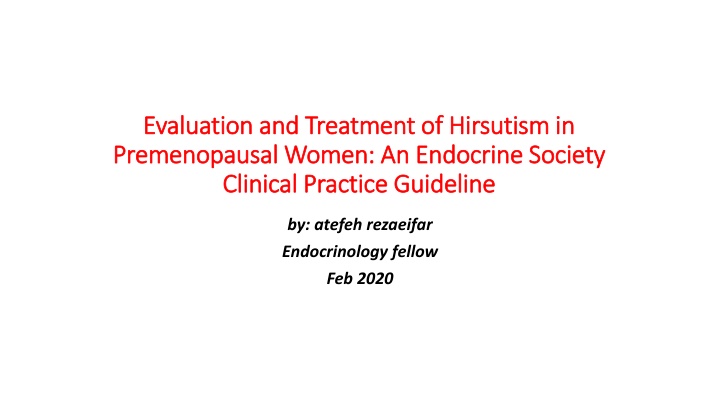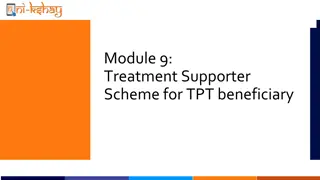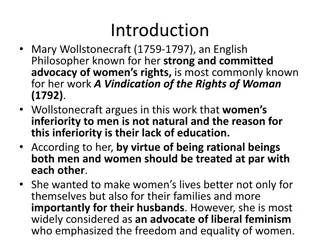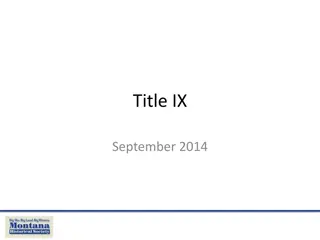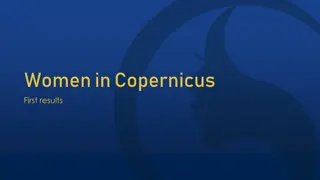Evaluation and Treatment of Hirsutism in Premenopausal Women
Hirsutism is defined by excess terminal hair growth in androgen-dependent areas, affecting 5 to 10 percent of women and often associated with emotional distress. Elevated serum androgens can lead to manifestations such as hirsutism, acne, and virilization. The Ferriman-Gallwey score is used to grade hair growth, with scores indicating mild, moderate, or severe hirsutism. Limitations of this scoring system include failure to account for locally high scores and lack of consideration for specific areas. Effective evaluation and treatment are crucial for managing hirsutism in premenopausal women.
Download Presentation

Please find below an Image/Link to download the presentation.
The content on the website is provided AS IS for your information and personal use only. It may not be sold, licensed, or shared on other websites without obtaining consent from the author.If you encounter any issues during the download, it is possible that the publisher has removed the file from their server.
You are allowed to download the files provided on this website for personal or commercial use, subject to the condition that they are used lawfully. All files are the property of their respective owners.
The content on the website is provided AS IS for your information and personal use only. It may not be sold, licensed, or shared on other websites without obtaining consent from the author.
E N D
Presentation Transcript
Evaluation and Treatment of Hirsutism in Evaluation and Treatment of Hirsutism in Premenopausal Women: An Endocrine Society Premenopausal Women: An Endocrine Society Clinical Practice Guideline Clinical Practice Guideline by: atefeh rezaeifar Endocrinology fellow Feb 2020
Definition, Pathogenesis, and Etiology of Hirsutism : Definition, Pathogenesis, and Etiology of Hirsutism : Hirsutism is a clinical diagnosis defined by the presence of excess terminal hair growth (dark, coarse hairs) in androgen-dependent areas (upper lip, chin, midsternum, upper abdomen, lower abdomen,upper and lower back,inner thight ,upper arm) in which women typically have little or no hair. Hirsutism is an important clinical problem because: 5 to 10 percent of women significant emotional distress and depression underlying endocrine disorder (most[PCOS])
Elevated serum concentrations of androgens in women are referred to as hyperandrogenemia, which can manifest as hyperandrogenism: hirsutism, acne, androgenetic alopecia, and virilization. Virilization, which is rare, occurs only with severe hyperandrogenism and includes deepening of the voice and clitoromegaly.
Hair growth can be graded as either normal or excessive based upon the Ferriman-Gallwey score. Ferriman Gallwey total scores that define hirsutism in women of reproductive age are as follows: USA and uk black or white women, 8 Mediterranean, Hispanic, and Middle Eastern women, 9 to 10 South American women, 6 Asian women, a range of 2 for Han Chinese women to 7 for Southern Chinese women . Scores between 8 and 15 are usually considered to be mild hirsutism, 16 to 25 moderate, and scores >25 severe hirsutism.
Limitations: 1-failure to account for a locally high score that does not raise the total score to an abnormal extent, 2-lack of consideration of such androgen sensitive areas such as the sides of the face from the hairline to below the ear (sideburns) and the buttocks. 3-Many clinicians are unfamiliar with the Ferriman-Gallwey score and are therefore unlikely to use it.
Hirsutism must be distinguished from hypertrichosisgeneralized Excessive hair growth that may be hereditary or result from certain medications(phenytoin, cyclosporine). Hypertrichosis is distributed in a generalized, nonsexual pattern (predominantly on forearms or lower legs) and is not caused by excess androgen (although hyperandrogenemia may aggravate it).
Pathogenesis of hirsutism: The growth of sexual hair is entirely dependent on the presence of androgen Androgens appear to induce vellus follicles in sex specific areas to develop into terminal hairs, which are larger and more heavily pigmented. Hairs grow in nonsynchronous cycles, and the growth (anagen) phase (which varies with body area) ~4 months for facial hair. Due to the long hair growth cycle, it takes ~6 months to detect the effects of hormonal therapy and ~9 months for these effects to become maximal. Hirsutism results from an interaction between the plasma androgens and the apparent sensitivity of the hair follicle to androgen.
The sensitivity of the hair follicle is determined in part by the local metabolism of androgens, particularly by conversion of testosterone to dihydrotestosterone by the enzyme 5a-reductase and subsequent binding of these molecules to the androgen receptor. The hirsutism score does not correlate well with the androgen level apparently because the androgen-dependent pilosebaceous follicle response to androgen varies considerably.
Etiology of hirsutism: The majority of hirsutism is due to androgen excess( 80%), and the majority of women with hirsutism (70%to 80%) have PCOS . PCOS is defined by the presence of a combination of two of three symptoms orfindings: unexplained chronic hyperandrogenism, oligoovulation, and ultrasonographic polycystic ovarian morphology .
PCOS is frequently associated with a metabolic syndrome that results from insulin resistance and/or central obesity and that requires considerations distinct from those for hirsutism itself. Obesity may worsen or cause features of PCOS .
Many women have hirsutism without hyperandrogenemia. We term this idiopathic hirsutism in eumenorrheic women who have no other clinical evidence suggesting PCOS or other hyperandrogenic endocrine Disorder. although some may have polycystic ovary morphology on ultrasound and thus meet a Rotterdam criterion for ovulatory PCOS . Idiopathic hirsutism constitutes 5% to 20%of hirsute women. Available data suggest that among eumenorrheic women with mild hirsutism (a Ferriman Gallwey hirsutism scoreof 8 to 15 in the United States), approximately half have idiopathic hirsutism.
However, the percentage of women with idiopathic hirsutism who meet Rotterdam criteria for ovulatory PCOS remains unclear. It is unclear whether idiopathic hirsutism is due to altered androgen mechanism of action within the hair follicle(referred to as cutaneous hyperandrogenism) or to other alterations in hair biology . Serum total testosterone is similar to and correlates well with serum androgenic bioactivity in young women with and without PCOS . Thus, hirsutism cannot currently be considered synonymous with clinical evidence of hyperandrogenism if serum total and free testosterone are normal.
Further workup of the eumenorrheic patient for mild hirsutism and a normal serum total testosterone is only clinically indicated if there is other clinical evidence to suggest the etiology is a hyperandrogenic endocrine disorder. among women with mild hirsutism, approximately half have idiopathic hirsutism. Plasma total and/or free testosterone levels are elevated in the remainder of cases of mild hirsutism and in most cases of more severe hirsutism. Most women with a two fold or greater elevation of serum androgen levels have some degree of hirsutism or an alternative pilosebaceous response, Such as excessive acne vulgaris, seborrhea, or female- or male pattern alopecia.
Other causes of androgen overproduction are infrequent . NCCAH, the most common of these disorders, is present in 4.2% of hyperandrogenic womenworldwide, although specific ethnic groups are at lower or higher risk . Androgen-secreting tumors are present in ~0.2% of hyperandrogenic women; over half are malignant . Clinicians must consider Cushing syndrome, acromegaly, hypothyroidism, and (rarely) hyperprolactinemia in the differential diagnosis of hirsutism, but patients typically will present with the features specific to these disorders. Clinicians must consider topical androgen use by a partner,exogenous androgens or anabolic steroids , valproic acid when evaluating patients with hirsutism.
We suggest testing for elevated androgen levels in all women with an abnormal hirsutism score. In those cases where serum total testosterone levels are normal, if sexual hair growth is moderate/severe or sexual hair growth is mild but there is clinical evidence of a hyperandrogenic endocrine disorder (such as menstrual disturbance or progression in spite of therapy), we suggest measuring an early morning serum total and free testosterone by a reliable specialty assay.
We suggest screening hyperandrogenemic women for NCCAH due to 21-hydroxylase deficiency by measuring early morning 17-hydroxy progesterone levels in the follicular phase or on a random day for those with amenorrhea or infrequent menses. In hirsute patients with a high risk of congenital adrenal hyperplasia (positive family history, member of a high-risk ethnic group), We suggest this screening even if serum total and free testosterone are normal.
We suggest against testing for elevated androgen levels in eumenorrheic women with unwanted local hair growth (in the absence of an abnormal hirsutism score) because of the low likelihood of identifying a medical disorder that would change management or outcome. hirsutism is a potential indication of an underlying hyperandrogenic disorder that may require specific treatment and may have distinct implications for fertility, medical risks, and genetic counseling
The goal in assessing hirsutism is to attempt to determine the specific etiology and to provide a baseline in case it becomes necessary to reassess the patient. provides an approach to assessing hyperandrogenemia that depends on both determining the presence and degree of hirsutism and assessing whether there is clinical evidence of PCOS, other hyperandrogenic endocrinopathies, Virilizing disorders, or androgenic medication use.
Menstrual irregularity, infertility, galactorrhea, central obesity, acanthosis nigricans, evidence of virilization (such as clitoromegaly, deepening of the voice, increasing muscularity) sudden-onsetor rapid-progression hirsutism, or hirsutism progression in spite of therapy suggests the presence of a hyperandrogenic endocrine disorder.
Because standard assays fail to detect androgenic drugs, clinicians should be diligent in their effort to obtain a history of anabolic or androgenic steroid use, particularly among athletes and patients who have endometriosis, sexual dysfunction, or partners who may use testosterone gel. Valproic acid is the only anticonvulsant medication that raises plasma testosteronelevels.
Because of the high frequency of PCOS, clinicians should check all hirsute women for evidence of anovulation(menstrual irregularity) or more subtle ovarian dysfunction that may present as infertility ,central obesity, abnormal carbohydrate and lipid metabolism, acanthosis nigricans, or a family history of type 2 diabetes mellitus. Clinicians can make a diagnosis of ovulatory PCOS in eumenorrheic women with hirsutism, polycystic ovary morphology, and normal levels of testosterone. It is unclear whether pelvic ultrasonography is cost effective in the management of idiopathic hirsutism (eumenorrheic hirsute women with normal testosterone levels and no other clinical evidence of PCOS).
Biochemical testing We suggest measuring serum androgens in all women with clinical evidence of hirsutism. The choice of additional tests is based upon the patient's presentation (time of onset, pace of progression, presence or absence of virilization, and menstrualcycle status). As noted, 75 to 80 percent of women who present with hirsutism have PCOS, but it is essential to identifythose who have a more serious cause (androgen- secreting tumors and ovarian hyperthecosis). "Unwanted hair" Excess hair that is not true hirsutism, ie, is not dark, coarse, and in androgen- dependent areas, does not need biochemical evaluation and does not respond to the pharmacologic therapies for androgen-dependent hair. 2020 UpToDate
Hirsutism and normal menstrual cycles: Women with hirsutism and normal menstrual cycles are most likely to fall into the category of PCOS or idiopathic hirsutism and are unlikely to have a more serious cause for their hirsutism. We suggest measuring only a serum total testosterone. Hirsutism with oligomenorrhea/amenorrhea: serum total testosterone (BhCG], prolactin, [FSH], [TSH]) and an early morning 17-hydroxyprogesterone (around 8 AM). Although the menstrual dysfunction will almost always be due to PCOS, or in some cases, nonclassic 21-hydroxylase deficiency, the possibilities of pregnancy, hyperprolactinemia, primary ovarian insufficiency, and thyroid disease should not be overlooked. 2020 UpToDate
Serum total testosterone is best assessed by liquid chromatography-tandem mass spectroscopy (LC-MS/MS), an accurateand specific method. With LC-MS/MS, the upper limit of normal for serum testosterone in women is in the 45 to 60ng/dL range (1.6 to 2.1 nmol/L). The immunoassays that are available in most hospital laboratories are not suitable to accurately measure testosterone in women . Free testosterone measured by equilibrium dialysis is more sensitive but must be performed in a specialty laboratory. Free testosterone by analog method ("direct") is not accurate and should not be ordered. Therefore, we do not routinely measure free testosterone. Women with PCOS have serum testosterone concentrations that may be in the normal range (10 to the upper limit ofnormal, which varies between 45 and 60 ng/dL depending upon the laboratory [0.69 to 2.1 nmol/L]), or elevated butbelow 150 ng/dL (5.2 nmol/L). Although the degree of hyperandrogenemia may not correlate well with the severity of hirsutism, it does appear to correlate with metabolic risks observed in women with PCOS
We do not suggest measuring DHEAS, because mildly elevated levels of DHEAS are unlikely to affect management. Inaddition, elevated DHEAS concentrations do not discriminate as well as serum testosterone between malignant and benign causes of adrenal hyperandrogenism. The role of serum androstenedione in the evaluation of PCOS and/or hirsutism is unclear . However, its measurement in some populations with PCOS, for example, Icelandic women, may be important for documenting hyperandrogenism. 2020 UpToDate
The evaluation of hyperandrogenemic women may include the following: pregnancy tests in patients with amenorrhea; Serum total testosterone free testosterone (DHEAS) to screen for adrenal hyperandrogenism; assessing for Cushing syndrome, thyroid dysfunction, acromegaly, and hyperprolactinemia if features of these conditions are present (however, all are uncommon causes of hirsutism); pelvic ultrasonography(preferably transvaginal) to detect an ovarian neoplasm in women with severe or progressive hyperandrogenism. Of note, some androgen-secreting ovarian tumors are too small to be detected by transvaginal ultrasound.
Further workup to identify the origin of androgen excess may be clinically indicated because of atypical clinical or laboratory findings and may include the following: (1) measuring serum androstenedione (the immediate precursor for testosterone) or other steroid intermediates (2) assessing the response to cosyntropin of 17-hydroxyprogesterone, DHEA, 17-hydroxypregnenolone, and 11-deoxycortisol, and/or genotyping to exclude rare forms of congenital adrenal hyperplasia.
(3) assessing urinary corticoid metabolites by mass spectrometry to exclude apparent cortisone reductase deficiency (4) dexamethasone suppression testing to suppress androgens arising from a functional adrenal source (5) adrenal computed tomography, ovarianultrasound, or more specialized imaging studies if there is reason to suspect an androgen-secreting tumor; (6) assessing the suppressive response to combined OC or gonadotropin-releasing hormone (GnRH) agonist Lastly, transvaginal ultrasound is also helpful if ovarian hyperthecosis is suspected; absence of follicles and or the polycystic ovarian morphology supports the diagnosis of hyperthecosis.
Salivary testosterone: correlates with serum-free testosterone, but methodologic differences have led to widely divergent values between laboratories, so we recommend against this methodology urinary testosterone : do not recommend measurements of urinary testosterone (testosterone glucuronide), as it is not a unique metabolite of serum testosteroneand therefore does not accurately reflect circulating testosterone.
There is no uniform laboratory standard for free orbioavailable testosterone levels, and so assay-specificresults differ widely. The most reliable methods compute the free testosterone concentration from total testosterone and SHBG concentrations or as the product of thetotal testosterone concentration and the fraction of testosterone that is free by equilibrium dialysis or not bound to SHBG.
It has long been known that testosterone is not the only naturally circulating androgen However, the routine assay of other known. serum androgenic steroids or precursors the prohormo(17-hydroxyprogesterone, androstenedione , DHEA, DHT,androstenediol) has been of little further diagnostic utility in most, but not all, populations . DHEAS is increased in 17% of hirsute women who have normal total and free testosterone levels . mildly elevated DHEAS level in the setting of normal free testosterone is unlikely to affect management. The magnitudeof the androgen level is of poor predictive value for tumors. although a very high testosterone or DHEAS level (>700 g/dL) is suggestive.
Williams 2020 Endocrinology
Treatment of Hirsutism in Premenopausal Women: For most women with patient-important hirsutism despite cosmetic measures, we suggest starting with pharmacological therapy . However, for women with mild hirsutism and no evidence of an endocrine disorder, we suggest either approach. For hirsute women with obesity, including those with PCOS, we also recommend lifestyle changes.
The development of hirsutism is mostly dependent on circulating androgen concentrations and the response of the hair follicle to the local androgen milieu. there are two main approaches to the management of hirsutism that may be used either individually or in combination: (1) pharmacologic therapies that target androgen production and action, (2) direct hair removal methods(electrolysis and photoepilation). We suggest pharmacotherapy as initial therapy for most women with patient- important hirsutism (adding direct hair removal methods later if needed).
In addition to cosmetic and/or pharmacologic therapy, lifestyle changes for obese women with PCOS may improve their hirsutism. However, lifestyle changes should not be considered a primary therapy for hirsutism, as their impact is not clinically significant, particularly when compared with OCs .
Pharmacological Treatments Initial therapies 1)For the majority of women with hirsutism who are not seeking fertility, we suggest OCs as initial therapy for treating patient-important hirsutism. 2)For most women with hirsutism, we suggest against antiandrogen monotherapy as initial therapy(because of the teratogenic potential of these medications) unless these women use adequate contraception. However, for women who are not sexually active, have undergone permanent sterilization, or who are using long-acting reversible contraception, we suggest using either OCs or antiandrogens as initial therapy . The choice between these options depends on patient preferences regarding efficacy, side effects, and cost.
3) For most women, we do not suggest one OC over another as initial therapy, as all OCs appear to be equally effective for hirsutism, and the risk of side effects is low. higher risk for VTE(obese or over age 39 years), we suggest initial therapy with an OC containing the lowest effective dose of ethinyl estradiol(EE) (usually 20 mcg) and a low-risk progestin. hirsutism remains despite 6months of monotherapy with an OC,we Suggest adding an antiandrogen.
We do not suggest one antiandrogen over another However, we recommend against the use of flutamide because of its potential hepatotoxicity. For all pharmacologic therapies for hirsutism, we suggest a trial of at least 6 months before making changes in dose, switching to a new medication, or adding medication. combination therapy (OC + antiandrogen): severe hirsutism causing emotional distress and/or in those women who have used OCs in the past and have not experienced sufficient improvement. However, we suggest against combination therapy as a standard first-line approach.
Combined oral estrogenprogestin contraceptives Most combined estrogen progestin OCs contain the potent, synthetic estrogen EE in combination with a progestin. Most progestins are derived from 19-nortestosteroneand exhibit varying degrees of androgenicity . progestins with low androgenicity:norgestimate, desogestrel, and gestodene; medium androgenicity : norethindrone; relatively high androgenicity :norgestrel and levonorgestrel.
CPA and DSP are structurally unrelated to testosterone and function as weak androgen receptor antagonists. Several Ocs contain DSP, a progestin structurally related to spironolactone that exhibits weak antiandrogenic activity. 3 mg DSP (the dose used in OCs) = 9 to 10 mg spironolactone. For comparison, 100 to 200 mg spironolactone is the therapeutic dose for hirsutism. 2 mg CPA (the dose used in OCs) =50 mg spironolactone
OC therapy reduces hyperandrogenism by the following mechanisms: 1)Suppression of luteinizing hormone secretion androgen secretion) (and therefore ovarian 2) Increased SHBG Stimulation of the hepatic production of (SHBG) increasing androgen binding in serum and reducing serum free androgen concentrations. Androgens and insulin both decrease the hepatic production of SHBG. Since both are often increased in hyperandrogenic women, these women have lower serum SHBG concentrations than normal Estrogen (and OCs) causes a dose-dependent increase in serum SHBG concentrations over three to four weeks in hyperandrogenic women.
3)Secondary mechanisms : decreasing adrenal androgen secretion inhibiting the peripheral conversion of testosterone to dihydrotestosterone (DHT), inhibiting the binding of DHT to androgen receptors. increase the metabolic clearance of testosterone
Combination OCs carry about a threefold increased risk of VTE in first-time users. VTE risk is significantly but weakly related to estrogen dose and may wane with duration of estrogen use. The use of OCs containing some of the recent-generation low-androgenicity progestins(desogestrel, gestodene), and androgen receptor antagonists (CPA, DSP) may confer a 50% to 100% increased risk of VTE compared with OCs containing the second generationprogestin levonorgestrel, according to reviews of large-scale comparative analyses.
Increased age and obesity are additional factors associated with an increased risk of VTE. The risk in women over age 39 years taking OCs is approximately fourfold higher than in younger women . The risk in obese women taking Ocs has been estimated to be 2- to 10-fold higher than nonobese women taking OCs
